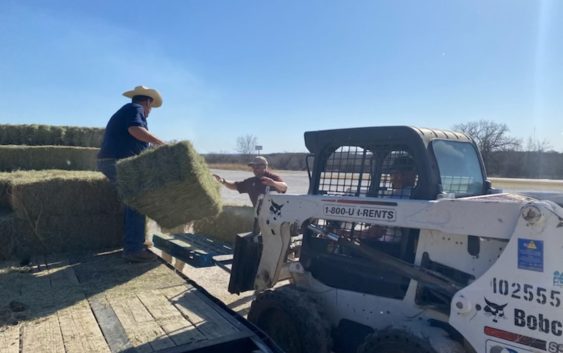- Texas’ biggest wildfire started a year ago. How does the Panhandle look now?
- To her, Hurricane Helene debris isn’t trash. It is full of memories — and she’s returning them
- Bills introduced a year after state’s largest blaze seek to limit wildfires
- A year after Texas’ largest wildfire, Panhandle residents tugged between hope and anxiety
- Another $500M for Hurricane Helene relief in North Carolina passes key hurdle
Wildfire Victims Receive Outpouring Of Generosity

The Texas A&M AgriLife Extension Service continues to provide support coordinating hay, livestock feed and fencing supplies to producers impacted by the Eastland Complex wildfire.
Fires encompassed more than 50,000 acres around Eastland and resulted in more than 400 dead livestock.
AgriLife Extension’s Disaster Assessment Response team was deployed March 18 to Eastland County to support animal needs assessments with the Texas A&M University Veterinary Emergency Team and Texas Animal Health Commission. Staging areas continue at the Texas Cattle Exchange in Eastland County with animal supply points at Rising Star, Cross Plains and Gorman.
“AgriLife Extension, along with its partners, continue to provide support to those affected by these devastating wildfires,” said Monty Dozier, Ph.D., AgriLife Extension director, Disaster Assessment Recovery, Bryan-College Station. “Our DAR agents have served in several capacities, whether coordinating intake and distribution of hay, feed and livestock, or assisting with field assessments. It’s truly been a team effort as we assist these producers during this time of great need.”
Logistical coordination
Bryan Davis, AgriLife Extension agent-emergency management, Sequin, said the challenges the wildfire presents are much different from other disasters he has responded to, including hurricanes, because the fire continues to burn.
“When we first got here on Friday, fires were still popping up everywhere,” Davis said. “I worked with Task Texas Force 2 and the chief of police in Carbon in response to a request to set up a staging operation at the Cattle Exchange. I also worked with Dr. Wesley Bissett and the TAMU Veterinary Emergency Team to work the flow of livestock coming in and coordinate where hay could be stacked safely from any embers, identifying a dry place for sack feed.”
Amid the fieldwork, Davis said DAR agents have been receiving calls for hay and feed donations. Through March 20, more than 400 round bales and several semi-truck loads of cattle cubes and fencing supplies were received. Davis said multiple staging areas are receiving round bales, feed and fencing supplies for livestock operations in the counties affected by the wildfires.

“Once the agency’s strike team agents came in, we coordinated work with the Texas Animal Health Commission and Texas and Southwestern Cattle Raisers Association conducting field assessments,” he said. “We would receive a call from a producer who had either cattle down or had cattle that died and needed assistance with removal. TSCRA rangers were also identifying proper owners of cattle.
“People know we have agents in every county, and we are a service agency. We’ve been working throughout COVID-19 providing various support efforts, so people know what we are capable of and how we fit into the system, what we can offer.”
Communities grateful for support, donations
TJ Cummings, AgriLife Extension agent for Eastland County, said, “People have been keeping me and the other agents swamped with hay, feed, fence materials, and dog and cat food by the pallets.”
One producer sent two semi-loads of bulk cubes and was working to send money to help those affected by the fire, Cummings said.
Cummings said many producers lost cattle and homes when wildfires swept through the same part of Texas in 2006. Some are providing help because they experienced losses then, but others are experiencing a second round of losses to fire.
He wanted to thank donors on behalf of fire victims, Eastland County and AgriLife Extension and said fencing material remains the top request from landowners impacted by the fire.
“It’s just mindboggling,” he said. “It’s very humbling what people have done to help here. We had some ladies at the auction today who were still working despite the fact their homes burned down and they lost their cattle. The grass will come back, but we’ve got a lot of lives and miles and miles of fence to rebuild.”